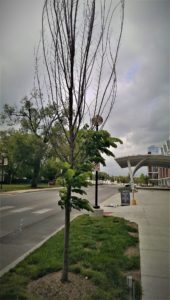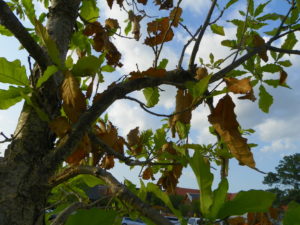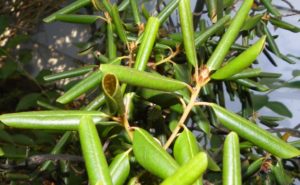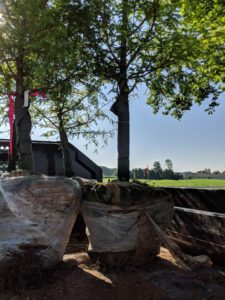An abiotic stress in plants is a stress due to a non-living factor, such as temperature, moisture, herbicides, etc. Biotic stress includes a living organism, such as a fungi, insect, etc. This series will explore some of the most common types of abiotic stress you may find in landscapes and nurseries.
We’ve all experienced the problem. Sometimes it’s barely noticeable, and other times it results in death. Even if you don’t notice, it most likely still occurred. Environmental conditions can be helpful, or quite the opposite.
- Figure 1. Dieback and leaf drop are common symptoms of transplant shock.
Of course, we are speaking of transplant shock.
Transplant shock occurs when plants become stressed due to poor root establishment, often mimicking drought stress. The severity of transplant shock is dependent on many factors, which include plant species, soil type/quality, moisture, temperature, growth stage of the plant, root loss from the nursery, as well as many other factors.
If transpiration rate (loss of water from the leaves) in the plant is high, transplant shock will increase. When humidity is low, temperature is high, and the wind is significant, transpiration rates are the highest. This is typically why we try to avoid transplanting in the summer months.
- Figure 2. Browning of leaves, leading to necrotic tissue is a common symptom of transplant shock.
A few of the symptoms of transplant shock include:
- Deciduous Plants
- Leaf wilt
- Drought-like symptoms occur when plants experience transplant shock.
- A cupping or rolling leaf can also occur, depending on species. (Fig. 3)
- Figure 3. Rolled leaves on some species, such as this azalea, is a common symptom of transplant shock.
- Leaf drop
- Some species will drop leaves when transplant shock occurs. The plant can develop an abscission layer at the base of the petiole, leading to leaf drop. This occurs to conserve water within the plant by decreasing leaf surface area (where the stomata are located and, thus, transpiration occurs.
- Leaf scorch
- Leaf scorch begins with a yellowing to the leaves, quickly followed by brown, dried leaves. The leaf veins remain intact, leaving a ‘skeletonized’ appearance.
- Abnormally small leaves
- New flushes of growth can be 25-50% the size of other leaves when transplant shock occurs. This is a response by the plant to reduce leaf surface area, but continuing to photosynthesize.
- Shortened internodes
- Since growth is reduced from the stress, internode length will be much less compared to previous years’ growth.
- Evergreen Plants
- Yellowing to browning of needles
- Transplant shock is much more difficult to diagnose and treat, because by the time that needles are brown, it’s often too late to treat.
- Evergreen plants will hold their color for many weeks with no signs of stress (think of a cut Christmas tree keeping the color through the holiday season). Unlike deciduous plants, there are no accessory buds to ‘grow out’ of the problem.
- Yellowing to browning of needles
- Leaf wilt
Transplant shock can be limited through several cultural practices:
- Irrigation
- Irrigation is the most important factor in limiting transplant shock. Too much water is just as deleterious as too little water. On trees, water 5 gallons, plus 5 gallons per caliper inch each week on newly transplanted species. This can be reduced or increased based on local weather and soil conditions.
- Proper Planting
- Planting at the proper depth, at the trunk flare, or just a little above in heavy soils, will allow a reduction in plant stress. A plant that is too deep can be susceptible to pathogens at the trunk and can receive too much water by the ‘bathtub effect’.
- Humidity
- Planting during dry periods will increase transpiration, thus increasing transplant shock. To remedy this, increase irrigation frequency.
- Root Loss
- Root loss, primarily on balled in burlap material, can be significant when moved from the nursery. By increasing water and planting at the proper time (spring or fall), transplant shock can be reduced. In the nursery, defoliation or antitranspirant sprays will aide in reducing transpiration, allowing the root to shoot ratio to increase.
- Figure 4. Balled in burlap trees can be at risk for transplant shock due to the number of roots removed at digging.
- Root loss, primarily on balled in burlap material, can be significant when moved from the nursery. By increasing water and planting at the proper time (spring or fall), transplant shock can be reduced. In the nursery, defoliation or antitranspirant sprays will aide in reducing transpiration, allowing the root to shoot ratio to increase.
- Poor Soil
- In many locations, we are planting in non-ideal soil conditions. Soil remediation can be performed by adding organic material, which can be utilized in most landscapes. DO NOT remediate each planting hole. If you only amend the planting hole, you will create a zone that water can’t penetrate and roots will only grow in the hole. Instead, amend the entire landscape bed.
- Planting Time
- Plant prior to bud break in the spring or after leaf fall in the fall. This will allow root growth and water channeling to occur prior to leaf break in the spring.
Many times we can’t control the planting time, humidity, or even poor soil conditions. When working on a job, the customer wants the plants installed now, not when it’s the ‘correct time’. In these cases, make sure you are visiting the plants once per week and water as needed. Trusting the customer to keep plants watered will provide very mixed results. In those cases, it may be useful to set up an automatic email that goes to the customers once per week as a ‘gentle reminder’. Be sure to mention that on many species, too much water is just as bad as too little water.



